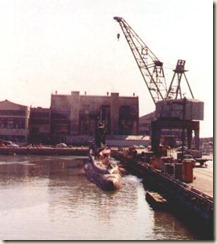Note: This blog post will make a little bit more sense if you read Part I (http://bit.ly/9gxOzx ) first.
It did not take me long to seize an opportunity to harass middy #2. He had the lowest of three bunks directly next to the 12” square hatch above my head at my watch station. His bunk consisted of what amounted to an aluminum box with a lid. The box was compartmentalized to accommodate his belongings. The lid held his mattress, which was contained in a Naugahyde cover.
To put my first attack into action, I only needed to wait until we were underway. To act to soon would allow him to counter my activity and make it of no effect. I would just bide my time for the next two weeks.
The day soon came when we cast off our lines and headed down the Firth of Clyde. As we sailed past the Isle of Arran on our starboard side and Ailsa Craig on our port side the crew would secure from the maneuvering watch and rig ship for dive. Life would become pretty much predictable and routine for the next seventy days or so.
After leaving the Clyde the Lee turned west and headed toward Ireland and then northwest and west into the open sea and our patrol area.
While life was predictable and routine it did not have to be boring. On this patrol I would do my part to make life interesting and exciting.
Middy #2 settled down into his routine, just like the rest of us. For him, this was a training cruise, not a holiday. He had a syllabus to follow and it would keep him plenty busy. I did not yet know it, but I would play a part in his required training. That story will have to wait until the next episode.
The crew, both officer and enlisted, are assigned duty stations for the various situations that normally occur on a submarine prior to leaving port. Watch stations were manned by persons formally qualified to stand them. If there were enough qualified watchstanders for a particular station three men would rotate on watch, six hours on and twelve hours off. If only two men were qualified it was usually twelve hours on and twelve ours off. Non-qualified personnel were assigned to a watch station as “under instruction” until they could pass the oral on-site examination. Midshipman fell into the later category and were assigned to various positions throughout their time on board.
Underway I stood all of my watches in the Torpedo Room. Every hour there were readings to record: pressures, temperatures, valve positions, switch positions, etc. Occasionally there were other duties to perform: torpedo and torpedo tube maintenance, field day (for the uninitiated, it is anything but), bleeding oxygen into the ship, and helping non-qualified sailors with their qualifications. Most of the time, there was little to do but remain alert and ready for emergencies. That gave me a lot of time to think about things that could get me into trouble.
I soon hatched a plan to get at middy #2: I would steal his tennis shoes, which were the shoe of choice on patrol, and paint one red and the other green. The left would be red, the right would be green. Just like the ship’s running lights. The next time Mr. Midshipman was sleeping in his bunk while I was on watch would be soon enough. I did the deed while he slept, and replaced his shoes by his bunk. I did it all without leaving my watch station, thanks to that little 12” X 12” hatch. The score was 1:0
The next time I saw the midshipman he was wearing his dress black shoes. I enquired of him why he had switched. He said someone had painted his shoes and he wasn’t going to wear them and have the crew make fun of him. The score was now 1:1.
I knew what I had to do. I now had to steal his dress shoes. He, knowing the same thing, was not going to allow that to happen. When he went to bed, his shoes were inside his bunk instead of on the deck next to it. I said nothing, did nothing. I knew that it was just a matter of time until he would forget. About two weeks later he lapsed and his shoes disappeared. The score now was 2:1.
Middy #2 next appeared in dress black shoes. He had two pair. The score: 2:2.
Again, I would have to wait. This time much longer. No way was he going to lose this pair. But time, lack of sleep, overwork, and exhaustion do take their toll and there was another lapse. I stole his second pair of shoes. The score: 3:2.
I didn’t see my friend for several days. When I did he was wearing his port and starboard tennis shoes. I laughed out loud and asked him what was going on with his shoes. He repeated to me the story (which I already knew) and expressed how hard it was for him to have to put them on and wear them publicly. But the hardest thing, he told me, was having to eat in the wardroom with the Captain. I asked what the Captain’s reaction was. He told me the Captain thought it was hilarious. The score: 4:2.
Well, Mr. Midshipman got used to his shoes and after awhile the crew stopped needling him about them. He wore them the rest of the patrol. Returning to port, however, did not end his agony.
As we made preparations to return to port I decided I would retrieve his shoes from their hiding places. The only thing was, I could not remember what I did with them. I was frantic. Where were they? I still don’t know. All I know is when we pulled alongside the tender, he did not have his dress shoes. I also knew he would need them for the change-of-command ceremony and our return to the States. I suspect someone else found his shoes or, knowing where I had hidden them, got them and sent them to Davey Jones’s locker.
Fortunately, the tender had a small stores (Navy lingo for an official store that sells uniform items) but my middy friend would have to wear his modified tennis shoes over there to buy a replacement for the ones that were lost.
It was not my intention to lose his shoes or to have him lose financially by having to buy another pair. Sometimes we lose control of a situation and it backfires on us. Fortunately, my friend mellowed as the patrol went on and we were both able to have a good laugh at the end — the end of the patrol, not my pranks.
 USS Tigrone in Phila. Navy Yard
USS Tigrone in Phila. Navy Yard




